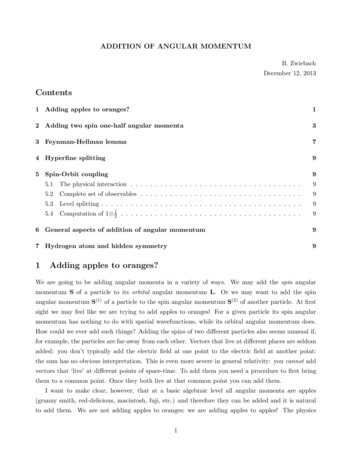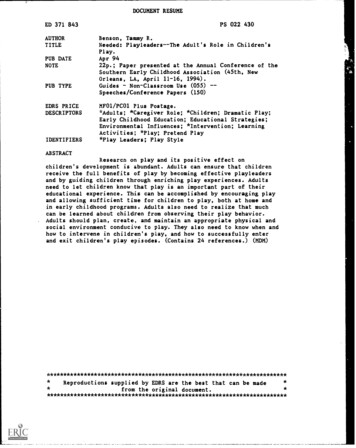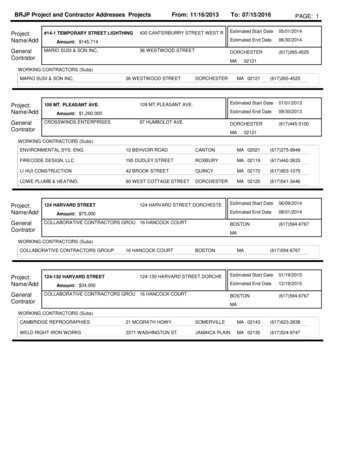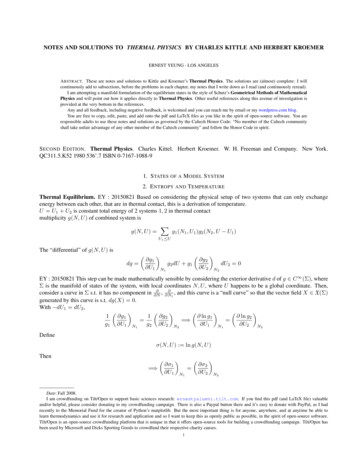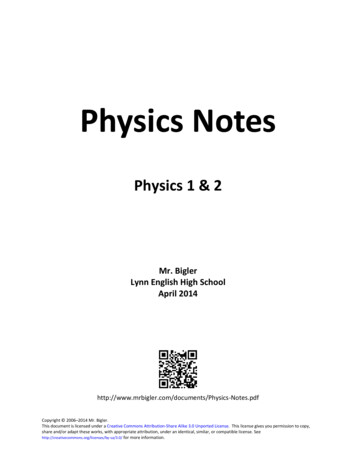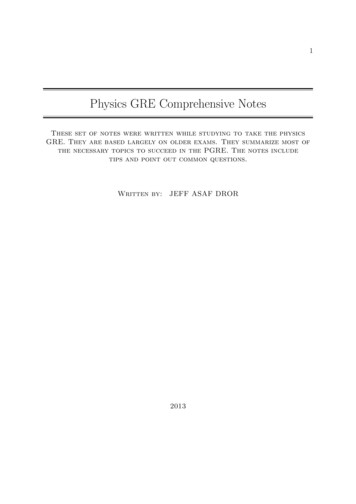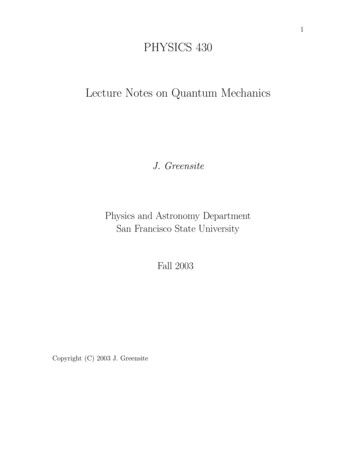
Transcription
1PHYSICS 430Lecture Notes on Quantum MechanicsJ. GreensitePhysics and Astronomy DepartmentSan Francisco State UniversityFall 2003Copyright (C) 2003 J. Greensite
2CONTENTSPart I - Fundamentals1. The Classical StateNewton’s Laws and the Principle of Least Action. The Euler-Lagrange equationsand Hamilton’s equations. Classical mechanics in a nutshell. The classical state.2. Historical Origins of Quantum MechanicsBlack-body radiation, the photoelectric effect, the Compton effect. Heisenberg’smicroscope. The Bohr atom. De Broglie waves.3. The Wave-like Behaviour of ElectronsElectron diffraction simplified: the ”double-slit” experiment and its consequences.The wave equation for De Broglie waves, and the Born interpretation. Why anelectron is not a wave.4. The Quantum StateHow does the electron get from A to B? Representation of the De Broglie ”wave”as a point moving on the surface of a unit sphere. Functions as vectors, wavefunctions as unit vectors in Hilbert space. Bra-ket notation. The Dirac delta function.Expectation value x and Uncertainty x in electron position.5. Dynamics of the Quantum StateEhrenfest’s principle. Schrodinger’s wave equation. The momentum and Hamiltonian operators. Time-independent Schrodinger equation. The free particle and thegaussian wavepacket. Phase velocity and group velocity. Motion of a particle in aclosed tube.6. Energy and UncertaintyExpectation value of energy, uncertainty of momentum. The Heisenberg Uncertainty Principle. Why the Hydrogen atom is stable. The energies of a particle in aclosed tube.7. Operators and ObservationsProbabilities from inner products. Operators and observables, Hermitian operators. States of ”zero uncertainty”; the eigenvalue equation. Commutators, and thegeneralized Uncertainty Principle.
3Part II - Exact Solutions8. Rectangular PotentialsQualitative behavior of energy eigenstates. Why bound state energies are discrete, why unbound eigenstates oscillate. Step potentials. The finite square well.Tunnelling, resonance, and the Ramsauer effect.9. The Harmonic OscillatorMotivation: the most important example in physics. Raising and lowering operators; algebraic solution for the energy eigenvalues. Hermite polynomials.10. Two Dimensions, Symmetry, and DegeneracyThe Parity operator in one dimension. The particle in a square.dimensional harmonic oscillator. The quantum corral.The two-11. The Spectrum of Angular MomentumMotion in 3 dimensions. Angular momentum operators, and their commutationrelations. Raising and lower operators; algebraic solution for the angular momentumeigenvalues. Spherical harmonics. The rigid rotator, and the particle in a sphericalbox.12. The Hydrogen AtomSeries solution for energy eigenstates. The scale of the world.Part III - Aspects of Spin13. Electron SpinEvidence for electron spin: the Zeeman effect. Matrix representation of spinangular momentum; Pauli spin matrices. Spin-orbit coupling as motivation to addangular momentum.14. The Addition of Angular MomentumThe general method. Atomic fine structure.15. Identical Particles and the Periodic TableBosons, Fermions, and the Pauli Exclusion Principle. The Hartree approximationfor many-electron atoms. The Periodic Table.16. Live Wires and Dead StarsThe Kronig-Penney model of electron band structure. The free electron gas andthe fermi energy. Degeneracy pressure, and the radii of neutron stars.
4Part IV - Approximation Methods17. Time-Independent Perturbation Theory18. Time-Dependent Perturbation TheoryAdiabatic, harmonic, and ”sudden” perturbations.19. The WKB and Rayleigh-Ritz ApproximationsWavefunctions of ”nearly classical” systems. Classical physics as a stationaryphase condition. The variational approach for estimating the ground state of a system.20. Scattering TheoryPartial waves. The Born approximationPart V - Advanced Topics21. Quantum Mechanics as Linear AlgebraReview of vectors and matrices. Linear algebra in bra-ket notation. Linear algebraand Hilbert space. The x and p representations. The harmonic oscillator, square well,and angular momentum representations. Canonical quantization. Poisson bracketsand commutators.22. The EPR Paradox and Bell’s TheoremEntangled States. The EPR ”paradox”. Faster than light? Bell’s Theorem.23. The Problem of MeasurementMixtures and pure states. The problem of measurement. Bohr and von Neumann interpretations. Bohm’s ”guiding waves”. The Many-Universe formulation.Decoherence and ”consistent histories” approaches.24. Feynman Path-Integral QuantizationThe action approach to quantum theory. From Schrodinger equation to Feynmanpath integral. Propagators. Functional Derivatives. Classical physics as a stationaryphase condition.25. A Glimpse of Quantum Field TheoryParticles as excited states of quantized fields. The quantization of sound. Thequantization of light. Casimir’s effect, and the structure of the Vacuum.
5APOLOGIAThese are my lecture notes for Physics 430 and 431, written a number of yearsago. They are still a bit incomplete: Chapters 19 and 20 remain to be written, andChapter 23 is unfinished. Perhaps this year I will get around to it. It is likely thatthere are still many misprints scattered here and there in the text, and I will begrateful if these are brought to my attention.
6
Chapter 1The Classical StateIn the first quarter of this century, it was discovered that the laws of motion formulatedby Galileo, Newton, Lagrange, Hamilton, Maxwell, and many others, were inadequateto explain a wide range of phenomena involving electrons, atoms, and light. After agreat deal of effort, a new theory (together with a new law of motion) emerged in 1924.That theory is known as quantum mechanics, and it is now the basic framework forunderstanding atomic, nuclear, and subnuclear physics, as well as condensed-matter(or ”solid-state”) physics. The laws of motion (due to Galileo, Newton,.) whichpreceded quantum theory are referred to as classical mechanics.Although classical mechanics is now regarded as only an approximation to quantum mechanics, it is still true that much of the structure of the quantum theory isinherited from the classical theory that it replaced. So we begin with a lightningreview of classical mechanics, whose formulation begins (but does not end!) withNewton’s law F ma.1.1Baseball, F ma, and the Principle of LeastActionTake a baseball and throw it straight up in the air. After a fraction of a second, orperhaps a few seconds, the baseball will return to your hand. Denote the height ofthe baseball, as a function of time, as x(t); this is the trajectory of the baseball. Ifwe make a plot of x as a function of t, then any trajectory has the form of a parabola(in a uniform gravitational field, neglecting air resistance), and there are an infinitenumber of possible trajectories. Which one of these trajectories the baseball actuallyfollows is determined by the momentum of the baseball at the moment it leaves yourhand.However, if we require that the baseball returns to your hand exactly t secondsafter leaving your hand, then there is only one trajectory that the ball can follow. Fora baseball moving in a uniform gravitational field it is a simple exercise to determine7
8CHAPTER 1. THE CLASSICAL STATEthis trajectory exactly, but we would like to develop a method which can be appliedto a particle moving in any potential field V (x). So let us begin with Newton’s lawF ma, which is actually a second-order differential equationd2 xdV (1.1)2dtdxIt is useful to reexpress this second-order equation as a pair of first-order equationsmdxp dtmdpdV (1.2)dtdxwhere m is the mass and p is the momentum of the baseball. We want to find thesolution of these equations such that x(t0 ) Xin and x(t0 t) Xf , where Xinand Xf are, respectively, the (initial) height of your hand when the baseball leavesit, and the (final) height of your hand when you catch the ball.1With the advent of the computer, it is often easier to solve equations of motionnumerically, rather than struggle to find an analytic solution which may or may notexist (particularly when the equations are non-linear). Although the object of thissection is not really to develop numerical methods for solving problems in baseball,we will, for the moment, proceed as though it were. To make the problem suitablefor a computer, divide the time interval t into N smaller time intervals of duration! t/N, and denote, for n 0, 1, ., N,tn t0 n! ,xn x(tn ) , pn p(tn ) ,x0 Xin ,(1.3)xN XfAn approximation to a continuous trajectory x(t) is given by the set of points {xn }connected by straight lines, as shown in Fig. [1.1]. We can likewise approximatederivatives by finite differences, i.e.!!!dxdt" x(tn 1 ) x(tn )xn 1 xn !!dpdt" p(tn 1 ) p(tn )pn 1 pn !!2"dxdt2t tnt tnt tn !1 dx ! dt1 !1)"t tn!dx dt"t tn 1 (xn 1 xn ) (xn xn 1 ) !!*(1.4)We will allow these positions to be different, in general, since you might move your hand toanother position while the ball is in flight.
1.1. BASEBALL, F MA, AND THE PRINCIPLE OF LEAST ACTION9and integrals by sums t0 tt0dt f (t) N 1,!f (tn )(1.5)n 0where f (t) is any function of time. As we know from elementary calculus, the righthand side of (1.4) and (1.5) equals the left hand side in the limit that ! 0, whichis also known as the continuum limit.We can now approximate the laws of motion, by replacing time-derivatives in (1.2)by the corresponding finite differences, and find- .pnxn 1 xn !m!"dV (xn )pn 1 pn !(1.6)dxnThese are iterative equations. Given position x and momentum p at time t tn ,we can use (1.6) to find the position and momentum at time t tn 1 . The finitedifference approximation of course introduces a slight error; xn 1 and pn 1 , computedfrom xn and pn by (1.6) will differ from their exact values by an error of order !2 .This error can be made negligible by taking ! sufficiently small.It is then possible use the computer to find an approximation to the trajectory inone of two ways: (i) the ”hit-or-miss” method; and (ii) the method of least action. The Hit-or-Miss MethodThe equations of motion (1.2) require as input both an initial position, in thiscase x0 Xin , and an initial momentum p0 which is so far unspecified. The methodis to make a guess for the initial momentum p0 P0 , and then use (1.2) to solve forx1 , p1 , x2 , p2 , and so on, until xN , pN . If xN Xf , then stop; the set {xn } is the(approximate) trajectory. If not, make a different guess p0 P0" , and solve again for{xn , pn }. By trial and error, one can eventually converge on an initial choice for p0such that xN Xf . For that choice of initial momentum, the corresponding set ofpoints {xn }, connected by straight-line segments, gives the approximate trajectory ofthe baseball. This process is illustrated in Fig. [1.2]. The Method of Least ActionLets return to the 2nd-order form of Newton’s Laws, written in eq. (1.1). Againusing (1.4) to replace derivatives by finite differences, the equation F ma at eachtime tn becomes/0m xn 1 xn xn xn 1dV (xn ) (1.7)!!!dxnThe equations have to be solved for n 1, 2, ., N 1, with x0 Xin and xN Xfkept fixed. Now notice that eq. (1.7) can be written as a total derivativeddxn)1 (xn 1 xn )2 1 (xn xn 1 )2m m !V (xn ) 02!2!*(1.8)
10CHAPTER 1. THE CLASSICAL STATEso that F ma can be interpreted as a condition that a certain function of xn shouldbe stationary. Let us therefore introduce a very important expression, crucial in bothclassical and quantum physics, which is known as the ”action” of the trajectory.The action is a function which depends on all the points {xn }, n 0, 1, ., N of thetrajectory, and in this case it isS[{xi }] N 1,n 011 (xn 1 xn )2m !V (xn )2!2(1.9)Then Newton’s Law F ma can be restated as the condition that the action functional S[{xi }] is stationary with respect to variation of any of the xi (except for theendpoints x0 and xN , which are held fixed). In other words 1dd N,1 (xn 1 xn )2S[{xi }] m !V (xn )dxkdxk n 0 2!12d1 (xk 1 xk )2 1 (xk xk 1 )2 m m !V (xk )dxk 2!2! ! { ma(tk ) F (tk )} 0 for k 1, 2, ., N 1)*(1.10)This set of conditions is known as the Principle of Least Action. It is the principlethat the action S is stationary at any trajectory {xn } satisfying the equations ofmotion F ma, eq. (1.7), at every time {tn }.The procedure for solving for the trajectory of a baseball by computer is to program the computer to find the set of points {xn } which minimizes the quantityQ ,k! S xk"2(1.11)The minimum is obtained at Q 0, where S is stationary. This set of points, joinedby straight-line segments, gives us the approximate trajectory of the baseball.Problem: Do it on a computer by both methods.
1.1. BASEBALL, F MA, AND THE PRINCIPLE OF LEAST ACTION11Problem: Dyre’s Dilemma2In discussing the motion of the baseball, we have been ignoring a lot of detailsabout baseballs, such as the composition of the interior, the pattern of the stitching,and the brand-name printed on the surface. Instead, the baseball has been treatedas though it were essentially a structureless point of mass m. It is necessary tomake idealizations like this in physics; the real world is otherwise too complicated todescribe. But sometimes an idealization misses something crucial. See if you can findwhat goes wrong in the following argument, which tries to prove that a rolling wheel(or, for that matter, a rolling baseball) can never come to rest through friction withthe ground.”Proof”: As shown in Fig. [1.3], the forward momentum of a wheel in the positivex-direction can only be eliminated by a force applied in the opposite direction. Butthe only place this force could be applied by friction is the point where the wheeltouches the ground. And a force in the negative x-direction, applied at this point,will have the effect of making the wheel spin faster! Therefore, the wheel will nevercome to rest due to friction. QED.Is this reasoning correct? Can you solve Dyre’s Dilemma?2I owe this exercise to Dr. Jeppe Dyre, Roskilde University, Denmark.
121.2CHAPTER 1. THE CLASSICAL STATEEuler-Lagrange and Hamilton’s EquationsIn brief, the Euler-Lagrange equations are the second-order form of the equations ofmotion (1.1), while Hamilton’s equations are the first-order form (1.2). In either form,the equations of motion can be regarded as a consequence of the Principle of LeastAction. We will now re-write those equations in a very general way, which can beapplied to any mechanical system, including those which are much more complicatedthan a baseball.We begin by writingS[{xi }] whereN 1,!L[xn , ẋn ](1.12)n 01L[xn , ẋn ] mẋ2n V (xn )2(1.13)and wherexn 1 xn(1.14)!L[xn , ẋn ] is known as the Lagrangian function. Then the principle of least actionrequires that, for each k, 1 k N 1,ẋn N 1,dd!S[{xi }] L[xn , ẋn ]0 dxkn 0 dxkN 1, L[xn , ẋn ] dẋn !L[xk , ẋk ] ! xk ẋndxkn 0and, since(1.15)1n k 1!dẋn1 ! n kdxk 0 otherwise this becomes 1L[xk , ẋk ] xk!)(1.16)* L[xk , ẋk ] L[xk 1 , ẋk 1 ] 0 ẋk ẋk 1(1.17)Recalling that xn x(tn ), this last equation can be written! L[x, ẋ] x"t tn1 !)! L[x, ẋ] ẋ"t tn! L[x, ẋ] ẋ"t tn !* 0(1.18)This is the Euler-Lagrange equation for the baseball. It becomes simpler when wetake the ! 0 limit (the ”continuum” limit). In that limit, we haveẋn S xn 1 xndx ẋ(t) !dtN 1,n 1!L[xn , ẋn ] S t0 tt0dt L[x(t), ẋ(t)](1.19)
1.2. EULER-LAGRANGE AND HAMILTON’S EQUATIONS13where the Lagrangian function for the baseball is1L[x(t), ẋ(t)] mẋ2 (t) V [x(t)]2and the Euler-Lagrange equation, in the continuum limit, becomes Ld L 0 x(t) dt ẋ(t)(1.20)(1.21)For the Lagrangian of the baseball, eq. (1.20), the relevant partial derivatives are LdV [x(t)] x(t)dx(t) L mẋ(t) ẋ(t)(1.22)which, when substituted into eq. (1.21) givem 2 x dV 0 t2dx(1.23)This is simply Newton’s law F ma, in the second-order form of eq. (1.1).We now want to rewrite the Euler-Lagrange equation in first-order form. Ofcourse, we already know the answer, which is eq. (1.2), but let us ”forget” thisanswer for a moment, in order to introduce a very general method. The reason theEuler-Lagrange equation is second-order in the time derivatives is that L/ ẋ is firstorder in the time derivative. So let us define the momentum corresponding to thecoordinate x to be Lp (1.24) ẋThis gives p as a function of x and ẋ, but, alternatively, we can solve for ẋ as afunction of x and p, i.e.ẋ ẋ(x, p)(1.25)Next, we introduce the Hamiltonian functionH[p, x] pẋ(x, p) L[x, ẋ(x, p)](1.26)Since ẋ is a function of x and p, H is also a function of x and p.The reason for introducing the Hamiltonian is that its first derivatives with respect to x and p have a remarkable property; namely, on a trajectory satisfying theEuler-Lagrange equations, the x and p derivatives of H are proportional to the timederivatives of p and x. To see this, first differentiate the Hamiltonian with respect top, H p ẋ p ẋ ẋ(x, p) L ẋ(p, x) p ẋ p(1.27)
14CHAPTER 1. THE CLASSICAL STATEwhere we have applied (1.24). Next, differentiating H with respect to x, H x ẋ(x, p) L L ẋ(p, x) x x ẋ x L (1.28) xUsing the Euler-Lagrange equation (1.21) (and this is where the equations of motionenter), we find p H xd Ldt ẋdp (1.29)dtThus, with the help of the Hamiltonian function, we have rewritten the single 2ndorder Euler-Lagrange equation (1.21) as a pair of 1st order differential equations dx H dt pdp H (1.30)dt xwhich are known as Hamilton’s Equations.For a baseball, the Lagrangian is given by eq. (1.20), and therefore the momentumis Lp mẋ(1.31) ẋThis is inverted to givepẋ ẋ(p, x) (1.32)mand the Hamiltonian isH pẋ(x, p) L[x, ẋ(x, p)]45p1p p m( )2 V (x)m2 m2p V (x)(1.33)2mNote that the Hamiltonian for the baseball is simply the kinetic energy plus thepotential energy; i.e. the Hamiltonian is an expression for the total energy of thebaseball. Substituting H into Hamilton’s equations, one findsdx p2p V (x) dt p 2mm12dp p2dV V (x) dt x 2mdx12which is simply the first-order form of Newton’s Law (1.2).(1.34)
1.3. CLASSICAL MECHANICS IN A NUTSHELL1.315Classical Mechanics in a NutshellAll the machinery of the Least Action Principle, the Lagrangian Function, and Hamilton’s equations, is overkill in the case of a baseball. In that case, we knew the equationof motion from the beginning. But for more involved dynamical systems, involving,say, wheels, springs, levers, and pendulums, all coupled together in some complicatedway, the equations of motion are often far from obvious, and what is needed is somesystematic way to derive them.For any mechanical system, the generalized coordinates {q i} are a set of variables needed to describe the configuration of the system at a given time. These couldbe a set of cartesian coordinates of a number of different particles, or the angulardisplacement of a pendulum, or the displacement of a spring from equilibrium, or allof the above. The dynamics of the system, in terms of these coordinates, is given by aLagrangian function L, which depends on the generalized coordinates {q i } and theirfirst time-derivatives {q̇ i }. Normally, in non-relativistic mechanics, we first specify1. The LagrangianL[{q i q̇ i }] Kinetic Energy Potential Energy(1.35)One then defines2. The ActionS dt L[{q i }, {q̇ i}](1.36)From the Least Action Principle, following a method similar to the one we used forthe baseball (see Problem 4), we derive3. The Euler-Lagrange Equations Ld L 0 q i dt q̇ i(1.37)These are the 2nd-order equations of motion. To go to 1st-order form, first define4. The Generalized Momentapi L q̇ i(1.38)which can be inverted to give the time-derivatives q̇ i of the generalized coordinatesin terms of the generalized coordinates and momentaq̇ i q̇ i [{q n , pn }]Viewing q̇ as a function of p and q, one then defines(1.39)
16CHAPTER 1. THE CLASSICAL STATE5. The HamiltonianH[{q i, pi }] ,npn q̇ n L[{q i , q̇ i }](1.40)Usually the Hamiltonian has the formH[p, q] Kinetic Energy Potential Energy(1.41)Finally, the equations of motion in 1st-order form are given by6. Hamilton’s Equations H pi H i qq̇ i ṗi(1.42)
1.3. CLASSICAL MECHANICS IN A NUTSHELL17Example: The Plane PendulumOur pendulum is a mass m at the end of a weightless rigid rod of length l, whichpivots in a plane around the point P. The ”generalized coordinate”, which specifiesthe position of the pendulum at any given time, is the angle θ (see Fig. [1.4]).1. Lagrangian1L ml2 θ̇2 (V0 mgl cos(θ))(1.43)2where V0 is the gravitational potential at the height of point P , which the pendulumreaches at θ π/2. Since V0 is arbitrary, we will just set it to V0 0.2. The ActionS t1 t0dt41 2 2ml θ̇ mgl cos(θ)25(1.44)3. Euler-Lagrange EquationsWe have L mgl sin(θ) θ L ml2 θ̇ θ̇(1.45)and thereforeml2 θ̈ mgl sin(θ) 0(1.46)is the Euler-Lagrange form of the equations of motion.4. The Generalized Momentump L ml2 θ̇ θ̇(1.47)pml2(1.48)5. The HamiltonianInsertθ̇ into1H pθ̇ ml2 θ̇2 mgl cos(θ)24to getH 1 p2 mgl cos(θ)2 ml25(1.49)(1.50)
18CHAPTER 1. THE CLASSICAL STATE6. Hamilton’s equations Hp pml2 Hṗ mgl sin(θ) θθ̇ (1.51)which are easily seen to be equivalent to the Euler-Lagrange equations.Problem - Two pointlike particles moving in three dimensions have masses m1 andm2 respectively, and interact via a potential V (x%1 x%2 ). Find Hamilton’s equationsof motion for the particles.Problem - Suppose, instead of a rigid rod, the mass of the plane pendulum isconnected to point P by a weightless spring. The potential energy of the spring is1k(l l0 )2 , where l is the length of the spring, and l0 is its length when not displaced2by an external force. Choosing l and θ as the generalized coordinates, find Hamilton’sequations.1.4The Classical StatePrediction is rather important in physics, since the only reliable test of a scientifictheory is the ability, given the state of affairs at present, to predict the future.Stated rather abstractly, the process of prediction works as follows: By a slightdisturbance known as a measurement, an object is assigned a mathematical representation which we will call its physical state. The laws of motion are mathematicalrules by which, given a physical state at a particular time, one can deduce the physical state of the object at some later time. The later physical state is the prediction,which can be checked by a subsequent measurement of the object (see Fig. [1.5]).From the discussion so far, its easy to see that what is meant in classical physicsby the ”physical state” of a system is simply its set of generalized coordinates andthe generalized momenta {q a , pa }. These are supposed to be obtained, at some timet0 , by the measurement process. Given the physical state at some time t, the stateat t ! is obtained by the rule:! Hq (t !) q (t) ! paaapa (t !) pa (t) !!" H q a"t(1.52)tIn this way, the physical state at any later time can be obtained (in principle) to anarbitrary degree of accuracy, by making the time-step ! sufficiently small (or else, if
1.4. THE CLASSICAL STATE19possible, by solving the equations of motion exactly). Note that the coordinates {q a }alone are not enough to specify the physical state, because they are not sufficient topredict the future. Information about the momenta {pa } is also required.The space of all possible {q a , pa } is known as phase space. For a single particlemoving in three dimensions, there are three components of position and three components of momentum, so the ”physical state” is specified by 6 numbers (x, y, z, px , py , pz ),which can be viewed as a point in 6-dimensional phase space. Likewise, the physicalstate of a system of N particles consists of 3 coordinates for each particle (3N coordinates in all), and 3 components of momentum for each particle (3N momentumcomponents in all), so the state is given by a set of 6N numbers, which can be viewedas a single point in 6N-dimensional space.As we will see in the next lectures, classical mechanics fails to predict correctlythe behavior of both light and matter at the atomic level, and is replaced by quantummechanics. But classical and quantum mechanics have a lot in common: they bothassign physical states to objects, and these physical states evolve according to 1storder differential equations. The difference lies mainly in the contrast between aphysical state as understood by classical mechanics, the ”classical state”, and itsquantum counterpart, the ”quantum state”. This difference will be explored in thenext few lectures.
20CHAPTER 1. THE CLASSICAL STATE
Chapter 2Origins of Quantum MechanicsWhere do correct ideas come from? Do they drop from the sky? No! Are they innatein the mind? No! They come from social practice, and from it alone.- Mao Tse-TungThe suggestion that all matter is composed of atoms, and the name ”atom” itself,are due to the Greek thinker Democritus, who lived five centuries before Christ. Notuntil the 19th century, however, did evidence for this hypothesis begin to accumulate,particularly from thermodynamics. The evidence was indirect, but compelling: assuming that gases are composed of atoms, one could derive analytically the equationof state for ideal gases P V nRT , which had been discovered empirically by Boyleand others. In addition, assuming that solids as well as gases are composed of atoms,one could deduce their specific heats, which agreed fairly well with the experimentalvalues at high temperatures . By the early 20th century, improvements in technologyand the discovery of radioactivity had enabled physicists to study in some detail theinternal structure of atoms, the mass and charge of the electron, and the interactionof atoms with light.Certain aspects of atomic physics which emerged from these early investigationswere puzzling and even paradoxical, in the sense that the observed behavior of electrons, atoms, and light seemed in contradiction to the known laws of mechanics andelectromagnetism. These aspects fell roughly into three categories:1.The Particle-like Behavior of Light WavesBlack-body radiation, the photoelectric effect, the Compton effect.2.The Puzzling Stability of the AtomWhy doesn’t the electron fall into the nucleus? What is the origin of atomicspectra?3.The Wave-like Behavior of ParticlesElectron diffraction.21
22CHAPTER 2. ORIGINS OF QUANTUM MECHANICSQuantum mechanics emerged as an attempt to explain these phenomena and, asin the bible, the story begins with light.2.1Black-Body RadiationIsaac Newton believed that light is composed of particles, and he had good reasonto think so. All wave motion exibits interference and diffraction effects, which arethe signature of any phenomenon involving waves. Newton looked for these effectsby passing light through small holes, but no diffraction effects were observed. Heconcluded that light is a stream of particles.One of Newton’s contemporaries, Christian Huygens, was an advocate of the wavetheory of light. Huygens pointed out that the refraction of light could be explainedif light moved at different velocities in different media, and that Newton’s inabilityto find diffractive effects could be due simply to the insensitivity of his experiments.Interference effects are most apparent when wavelengths are comparable to, or largerthan, the size of the holes. If the wavelength of light were very small compared to thesize of the holes used by Newton, interference effects would be very hard to observe.Huygens turned out to be right. More sensitive optical experiments by Young(1801) and Fresnel demonstrated the interference and diffraction of light, and measurements by Foucault (1850) showed that the speed of light in water was differentfrom the speed of light in air, as required to explain refraction. Then Maxwell, in1860, by unifying and extending the laws of electricity and magnetism, demonstratedthat electric and magnetic fields would be able to propagate through space as waves, traveling with a velocity v 1/ µ0 !0 , which turned out to equal, within experimental error, the known velocity of light. Experimental confirmation of the existence ofelectromagnetic waves followed shortly after, and by the 1880s the view that light isa wave motion of the electromagnetic field was universally accepted.It is a little ironic that following this great triumph of the wave theory of light,evidence began to accumulate that light is, after all, a stream of particles (or, at least,light has particle properties which somehow coexist with its wave properties). Thefirst hint of this behavior came from a study of black-body radiation undertaken byMax Planck, which marks the historical beginning of quantum theory.Any object, at any finite temperature, emits electromagnetic radiation at all possible wavelengths. The emission mechanism is simple: atoms are composed of negatively charged electrons and positively charged nuclei, and upon collision with otheratoms these charges oscillate in some way. According to Maxwell’s theory, oscillatingcharges emit (and can also absorb) electromagnetic radiation. So it is no mysterythat if we have a metallic box whose sides are kept at some constant temperatureT , the interior of the box will be filled with electromagnetic radiation, which is constantly being emitted and reabsorbed by the atoms which compose the sides of thebox. There was, however, some mystery in the energy distribution of this radiationas a function of frequency.
2.1. BLACK-BODY RADIATION23The energy density of radiation in the box, as a function of frequency, is easilyworked out using the equipartition principle of statistical mechanics. The total energyis1Erad no. of degrees of freedom kT21 2 (no. of standing waves) kT2(2.1)where k is Boltzman’s constant and T is t
1. The Classical State Newton’s Laws and the Principle of Least Action. The Euler-Lagrange equations and Hamilton’s equations. Classical mechanics in a nutshell. The classical state. 2. Historical Origins of Quantum Mechanics Black-body radiation, the photoelectric effect, the Comp


